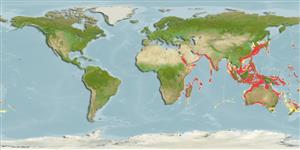Cardiomya alcocki (Smith, 1894)
| Native range | All suitable habitat | Point map | Year 2050 |

|
| This map was computer-generated and has not yet been reviewed. |
| Cardiomya alcocki AquaMaps Data sources: GBIF OBIS |
Google image | No image available for this species;
drawing shows typical species in Cuspidariidae.
Classification / Names Κοινά ονόματα | Συνώνυμα | CoL | ITIS | WoRMS
Bivalvia | Not assigned | Cuspidariidae
Environment: milieu / climate zone / εύρος βάθους / distribution range Οικολογία
; εύρος βάθους 60 - 1135 m (Αναφ. 108423), usually 60 - 300 m (Αναφ. 75831). Subtropical
Distribution Χώρες | Περιοχές FAO | Οικοσυστήματα | Παρουσίες | Εισαγωγές
Indo-West Pacific.
Length at first maturity / Μέγεθος / Weight / Age
Γεννητική Ωρίμανση: Lm ? range ? - ? cm
Life cycle and mating behavior Γεννητική Ωρίμανση | Αναπαραγωγή | Γεννοβολία | Eggs | Γονιμότητα | Larvae
Main reference
Αναφορές | Συντονιστής | Συνεργάτες
Bouchet, P. and R. von Cosel 2004 The world's largest Lucinid in an undescribed species from Taiwan (Mollusca: Bivalvia). Zoological Studies 43(4):704-711. (Αναφ. 8246)
IUCN Red List Status
(Αναφ. 130435: Version 2025-1)
CITES status (Αναφ. 108899)
CMS (Αναφ. 116361)
Threat to humans
Human uses
| FishSource |
Εργαλεία
Περισσότερες πληροφορίες
Σύσταση δίαιτας
Κατανάλωση τροφής
Θηρευτές
Max. ages / sizes
Length-weight rel.
Length-length rel.
Length-frequencies
Mass conversion
Αφθονία
Διαδικτυακές πηγές
BHL | BOLD Systems | CISTI | DiscoverLife | FAO(Publication : search) | Fishipedia | GenBank (genome, nucleotide) | GloBI | Gomexsi | Google Books | Google Scholar | Google | PubMed | Δέντρο Ζωής | Wikipedia (Go, αναζήτηση) | Zoological Record



